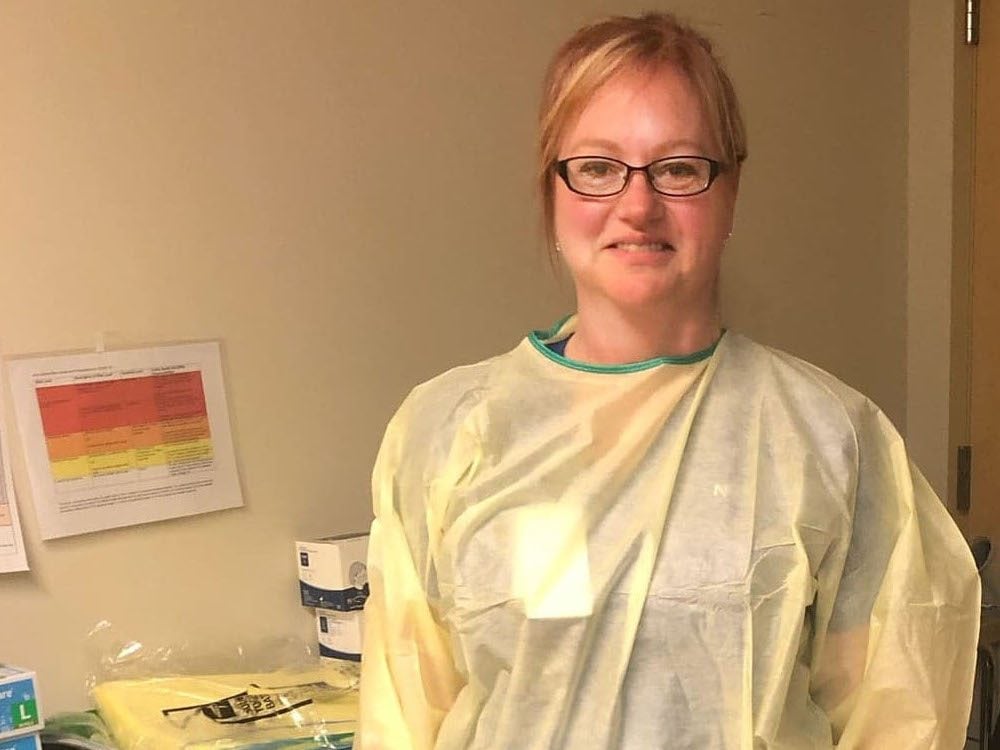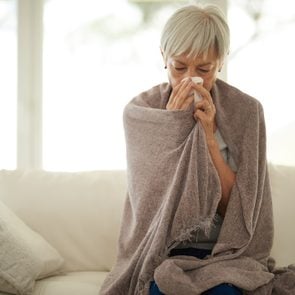I’m a Canadian ER Nurse—Here’s What It’s Like Fighting Coronavirus on the Front Line
I’ve worked through the rise of Ebola, H1N1, and SARS. But COVID-19 is the sneakiest—and perhaps most dangerous—virus I've ever seen.

Cynthia Rennie-Faubert, 48, nurse, Cornwall, Ont.
In January 2020, as I watched the news about the coronavirus outbreak in Wuhan, I kept thinking, ‘This is not good.’ As the situation escalated, I knew it was only a matter of time before it came to my hometown in Cornwall. And, on February 15, it did.
That day, we found out the government was sending over 100 Canadians citizens who were aboard the Diamond Princess, an infected cruise ship, to a hotel here for a 14-day quarantine. Suddenly, things got very real. As a nurse in the emergency department at Cornwall Community Hospital, I’d be treating any passengers with the virus. I didn’t even have time to fully absorb the news—I just grabbed my scrubs and sprang into action.
Understandably, news of the quarantine made a lot of people in Cornwall nervous. Our hospital team felt enormous pressure to keep everybody safe. We had to contain the potential spread and not allow any leakage into our community. Things moved fast. We immediately upped our isolation processes at the hospital. Our storerooms were filled with pandemic supplies, especially gowns and masks.
I often compare my job to being an air traffic controller. I’m responsible for moving patients through the department and making sure they have access to the right resources. With the possibility of cruise ship passengers being transported from quarantine to the hospital, I knew I had to be mentally prepared for every possibility. It wasn’t just about treating possible respiratory symptoms: most of the passengers were seniors and could need medical help for heart conditions, diabetes or even just general weakness.
At this point, there are two nurses assigned to the isolation area. Each must wear special personal protective gear over their scrubs. We get into our personal protective gear in an anteroom, which is used as an infection control measure before entering the isolation area. We do this between each and every suspected patient, putting on a fresh set of gear for every visit. It takes so much extra time that we brought in extra staff members. I’m working overtime to help pick up the slack.
Of course, there are times when it feels like the whole department is on fire. There are moments when we have multiple critical patients hanging in the balance, incoming trauma patients, and an overflowing waiting room. After all, in the ER, we’re still treating car accident injuries, heart attacks, strokes—anything you can think of, and a dozen things you can’t. And it’s all complicated by this virus. Say my team is running a Code Blue to resuscitate a patient. This happens often. But now, we have to think about the fact that, if a patient is unresponsive, we can’t ask for their medical or travel history. We can’t know if they’re infected. Right now, we don’t have the luxury of getting it wrong. We have to assume they could have the virus.
I felt so bad for the first cruise ship patients we treated—we were the first people they’d seen in a while, and our gear made us look like aliens! But they were very kind and patient. They were just aching to get home. Luckily, they didn’t have the virus. In the end, we averted disaster. Even better: all our emergency quarantine preparations gave the hospital a huge jumpstart as we all braced for the inevitable. I wasn’t at all surprised when, weeks later, after all the cruise ship passengers had gone home, the first case of COVID-19 in our community was confirmed.
I’ve been a nurse since 1994, so I’ve helped prepare for my fair share of outbreaks. I’ve worked through the rise of Ebola, H1N1, and SARS. But COVID-19 is a sneaky virus. This outbreak is scarier because patients can spread the virus while symptom-free. With SARS, it was clearer who was infected. With COVID-19, we have fewer clues that someone might be a carrier. On the plus side, past outbreaks taught us a lot about what to do now—especially when it comes to screening patients. During SARS, I wore my gown, gloves, mask and face shield for 12 hours straight at the front doors of the hospital, quizzing patients about respiratory symptoms as they entered the hospital. The gear seals in your body heat. I was sweating like crazy!
During this current outbreak, the mood at the hospital has definitely changed. Visitors are restricted. Tensions are high. Anyone entering the hospital is stopped at the entrance and asked about any recent travel and symptoms. If they don’t pass our screening test, we take patients directly into the isolation area of our Emergency Department for assessment. The trick throughout all of this is to stay calm and remind myself—and others!—that in most ways it’s just another ordinary day at work. We’re looking after sick patients in their time of need and taking precautions to keep ourselves safe as we do that.
Overall, I try to focus on the positive. For the majority of confirmed cases, the treatment is the same as for a common cold: stay home, stay hydrated, and rest. And, of course, wash your hands! As hospital staff, we have to stay calm and think clearly. I do that by taking things one patient at a time. It helps that my department is phenomenal. I couldn’t possibly do what I do without my fearless coworkers.
The only thing that scares me is if we reach a worst-case scenario. We only have so many ventilators, for example. I shudder at the thought of a “steal from Peter to pay Paul” situation emerging under the pandemic. That’s why I’m so proud of our national response. I’m happy people are practicing social distancing. And I see a huge shift in fewer people coming to the emergency department for small issues. People are trying to manage minor illnesses at home and I am so grateful.
I don’t think we’ve yet seen the full extent of this situation. I’m afraid the effects of COVID-19 are going to be felt for much longer than 14 days. That said, I believe my hospital will get through this. We’re a team. We’re all taking our turns working extra shifts. We know we have to be there for each other so we don’t burn out. In the meantime, I’ll stick to small traditions—like a celebratory breakfast after finishing a long string of night shifts.






